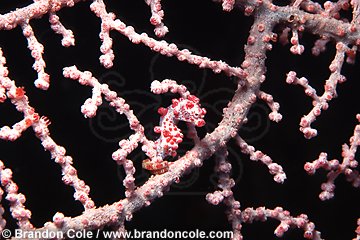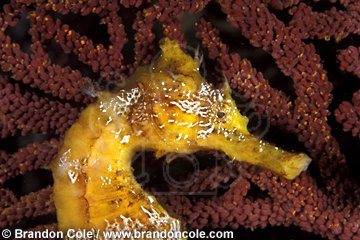|
photos of seahorses
To see more seahorse pictures,
click here
|

pygmy seahorse photos by professional
underwater photographer |

pacific seahorse photograph |

leafy sea dragon hires picture
South Australia |

underwater Caribbean photos
of longsnouted seahorses |
|
common
name |
numerous |
| scientific
name |
numerous |
| range |
worldwide,
primarily coastal, temperate and tropical |
viewing
hotspots |
numerous |
| habitat |
primarily
bottom-dwelling, in sea grass beds and coral reefs |
| size |
.5
inch (1cm) to 1 foot (30cm) |
| diet |
small
crustaceans |
| trivia |
males are
pregnant! 99% infant mortality; eyes rotate independently |
|
There are
currently about 34 species of seahorses recognized by the scientific
community, with another 200 or so pipefishes and kin. All are
members of the fish family Sygnathidae. A few of the most popular
are the Leafy Sea Dragon, Phycodurus eques, perhaps the most exotic
and unbelievable of all, resembling a tangle of sea weed adrift in
the cool waters of South Australia; the Estuary or Spotted Seahorse,
Hippocampus kuda; and one inch dynamo Hippocampus bargibanti, the
Pygmy Seahorse, a pink master of camouflage and mimicry living on
sea fans in the tropical Indo-Pacific Oceans.
Sea horses and their relatives have
slender, almost tubular bodies fashioned by encircling bony
segments. Most have elongated snouts (perfect for sucking up tiny
crustacean prey) and curved prehensile tails (perfect for clinging
to sea grasses and sponges). They are slow, often awkward swimmers
with small, feathery fins. Often difficult to spot thanks to their
ability to blend in with their surroundings, they are a favorite
with underwater photographers and critter hunters scuba diving and
snorkeling.
Seahorses also are big hits in private and
public aquariums throughout the world. And they are a key ingredient
in many traditional Chinese medicines. In fact, fishing pressure to
feed this demand has increased in recent years, and certain seahorse
populations in locations like the Philippines and Indonesia are
dangerously low.
Seahorses have a different approach to
domestic duties. Dad is Mom. After an elaborate, extended courtship
ritual complete with dancing and intertwined tails, the female sea
horse deposits her clutch of eggs (50 to 500 depending on species)
into a pouch on the male's abdomen, where fertilization occurs. Dad
is pregnant, technically and biologically. Mother makes regular
visits during the ensuing incubation period. Then Father gives
birth, labor pains and all. Baby seahorses emerge from the
pouch, fully formed and independent, and set off on their own.
|
|
| KEYWORDS
Pygmy Seahorse, Hippocampus bargibanti, pygmy, seahorse, pygmy seahorses,
sea horse, sea horses, camouflage, Pacific Seahorse, Hippocampus ingens,
pacific seahorses, pacific, Leafy Sea Dragon, Phycodurus eques, leafy, sea
dragon, sea dragons, sygnathidae, Longsnout Seahorse, Hippocampus reidi,
long snout, longsnouted, seahorses, pregnant, male, fish, photo, photos, photograph, photographs,
picture, pictures, stock, photography, marine, underwater |
|